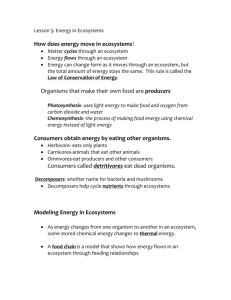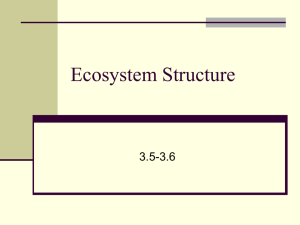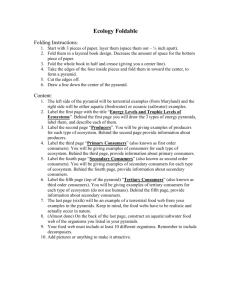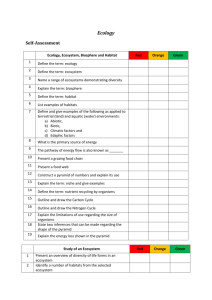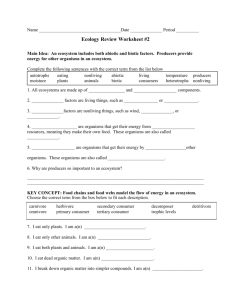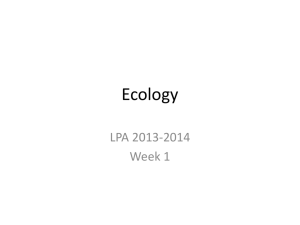Ecology Study Guide 1. What is the primary source of energy for
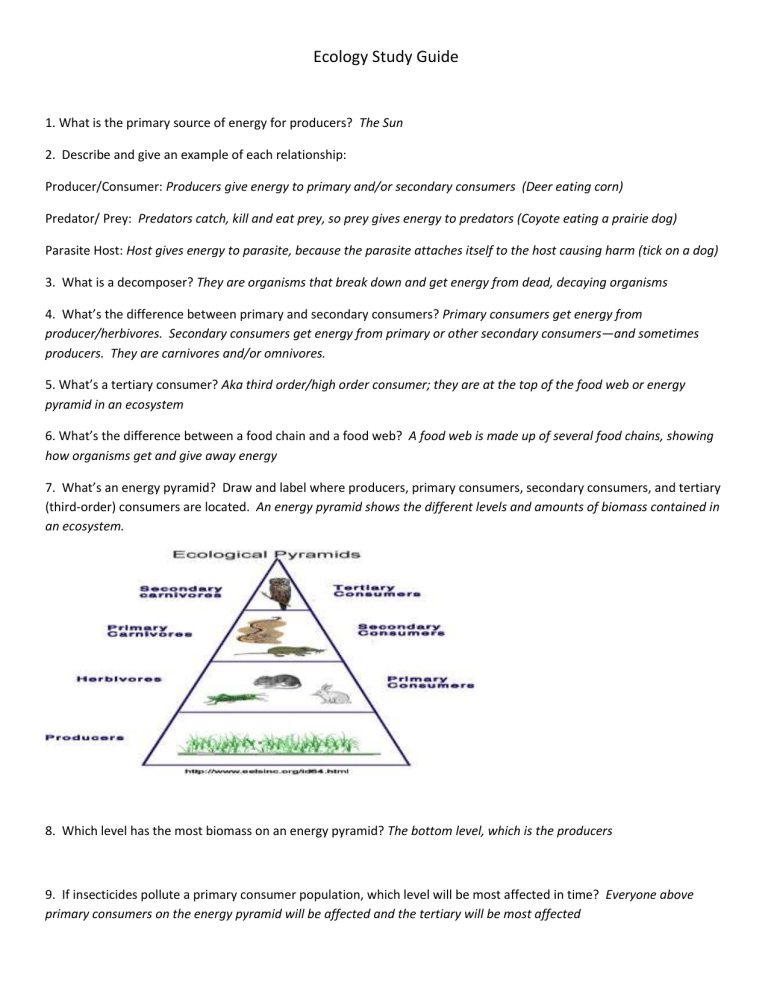
Ecology Study Guide
1. What is the primary source of energy for producers? The Sun
2. Describe and give an example of each relationship:
Producer/Consumer: Producers give energy to primary and/or secondary consumers (Deer eating corn)
Predator/ Prey: Predators catch, kill and eat prey, so prey gives energy to predators (Coyote eating a prairie dog)
Parasite Host: Host gives energy to parasite, because the parasite attaches itself to the host causing harm (tick on a dog)
3. What is a decomposer? They are organisms that break down and get energy from dead, decaying organisms
4. What’s the difference between primary and secondary consumers? Primary consumers get energy from producer/herbivores. Secondary consumers get energy from primary or other secondary consumers—and sometimes producers. They are carnivores and/or omnivores.
5. What’s a tertiary consumer? Aka third order/high order consumer; they are at the top of the food web or energy pyramid in an ecosystem
6. What’s the difference between a food chain and a food web? A food web is made up of several food chains, showing how organisms get and give away energy
7. What’s an energy pyramid? Draw and label where producers, primary consumers, secondary consumers, and tertiary
(third-order) consumers are located. An energy pyramid shows the different levels and amounts of biomass contained in an ecosystem.
8. Which level has the most biomass on an energy pyramid? The bottom level, which is the producers
9. If insecticides pollute a primary consumer population, which level will be most affected in time? Everyone above primary consumers on the energy pyramid will be affected and the tertiary will be most affected
10. Draw an example of a marine food web.
11. What is the difference between abiotic and biotic factors of an ecosystem? Give 3 examples of each.
Both are limiting factors
Abiotic is non-living factors; air, water, light, soil, temperature
Biotic is living or once-living factors; man, animal, plants
12. What factors does the carrying capacity of an ecosystem depend on?
Carrying capacity is the maximum amount of life an ecosystem can sustain and depends on the amount of food, water, and competition present
13. Of the following, which are primary and which are secondary consumers or both?
Herbivore--primary
Carnivore--secondary
Omnivore--secondary
14. What factors could contribute to the extinction of a species?
Pollutants such as insecticides and fuel emissions, oil spills, overpopulation, limited resources, hunting, overharvesting
15. What is produced through the chemical process of photosynthesis?
Oxygen and glucose
16. What could be some limitations of a food web model versus the activities in an actual ecosystem?
There are many different types of living organisms that interact in an ecosystem. Only a few are represented on a few web.
17. Distinguish between the following symbiotic relationships:
Mutualism: relationship in which both organisms benefit
Commensalism: relationship in which one organism benefits from another and the other is unaffected
Parasitism: relationship in which one organism benefit from another but the other is harmed
18. What kinds of environmental changes could negatively affect an ecosystem?
Pollution, harmful emissions, insecticides, overuse of fertilizers, urban runoff, oil spill, overharvesting, high rates of pH
(acid)

